Our vegan croissants are made with soft and aromatic brioche dough, rolled into the classic crescent shape, and baked to perfection until golden brown and pillowy soft.
You can eat vegan croissants as they are or filled with vegan custard or jam; either way, they are a delicious breakfast for all.
Our recipe is relatively easy to make and with simple ingredients that you already have in your pantry.
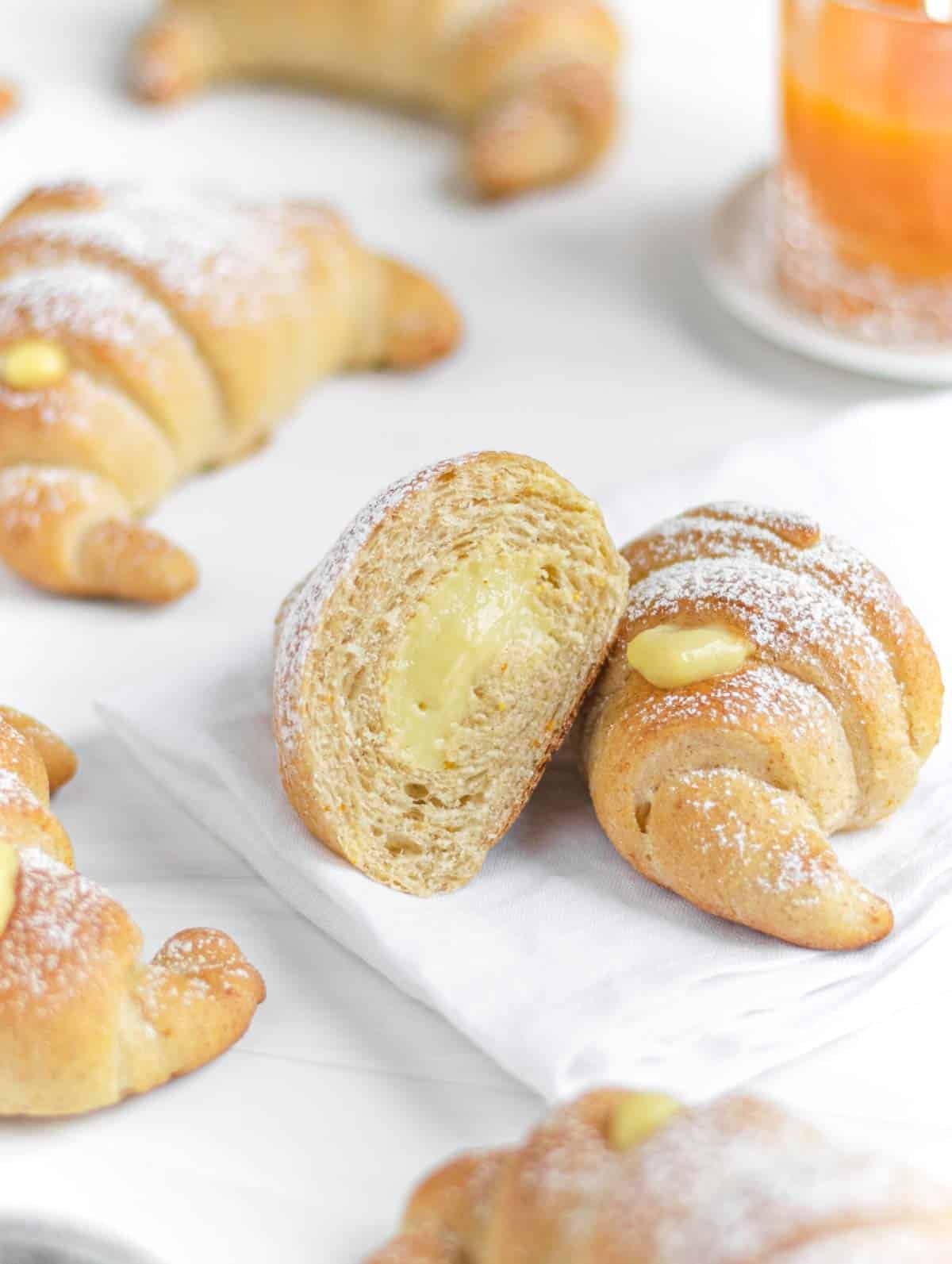
Table of Contents
Dietary Note: this recipe is suitable for a vegetarian and vegan diet. Not suitable for a gluten-free diet.
What are Vegan Croissants?
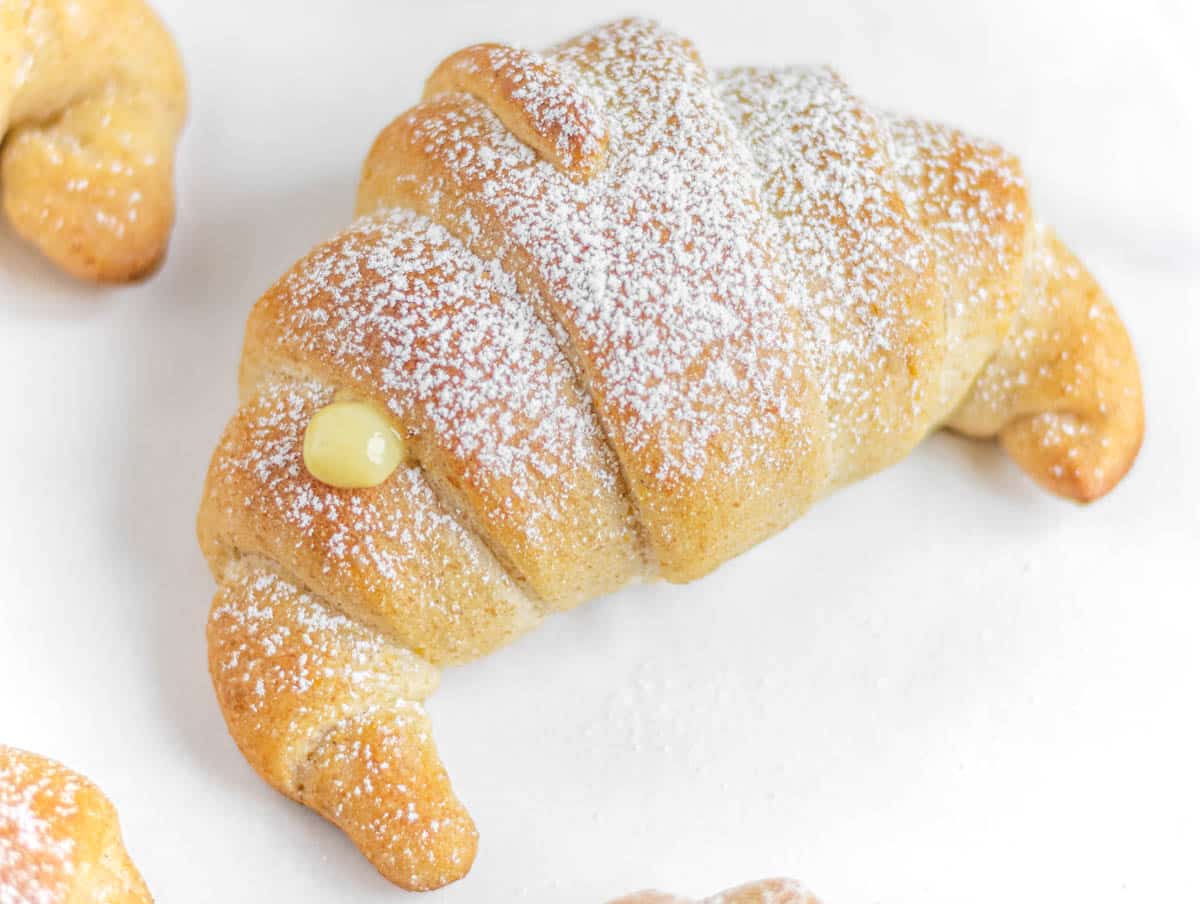
Our vegan croissants are inspired by Italian croissants and made with an aromatic and pillowy soft vegan brioche dough.
Unlike French croissants, which are delicious but difficult to make with laminate flaky layers of dough and butter, our vegan croissants are made with simple everyday ingredients and a straightforward process that makes them pillowy, soft, light, and airy.
While they don’t have a flaky texture, they are absolutely delicious!
We tested the brioche dough extensively in many other recipes, such as our Italian brioche buns, vegan brioche bread, vegan cinnamon rolls, and chocolate chip brioche.
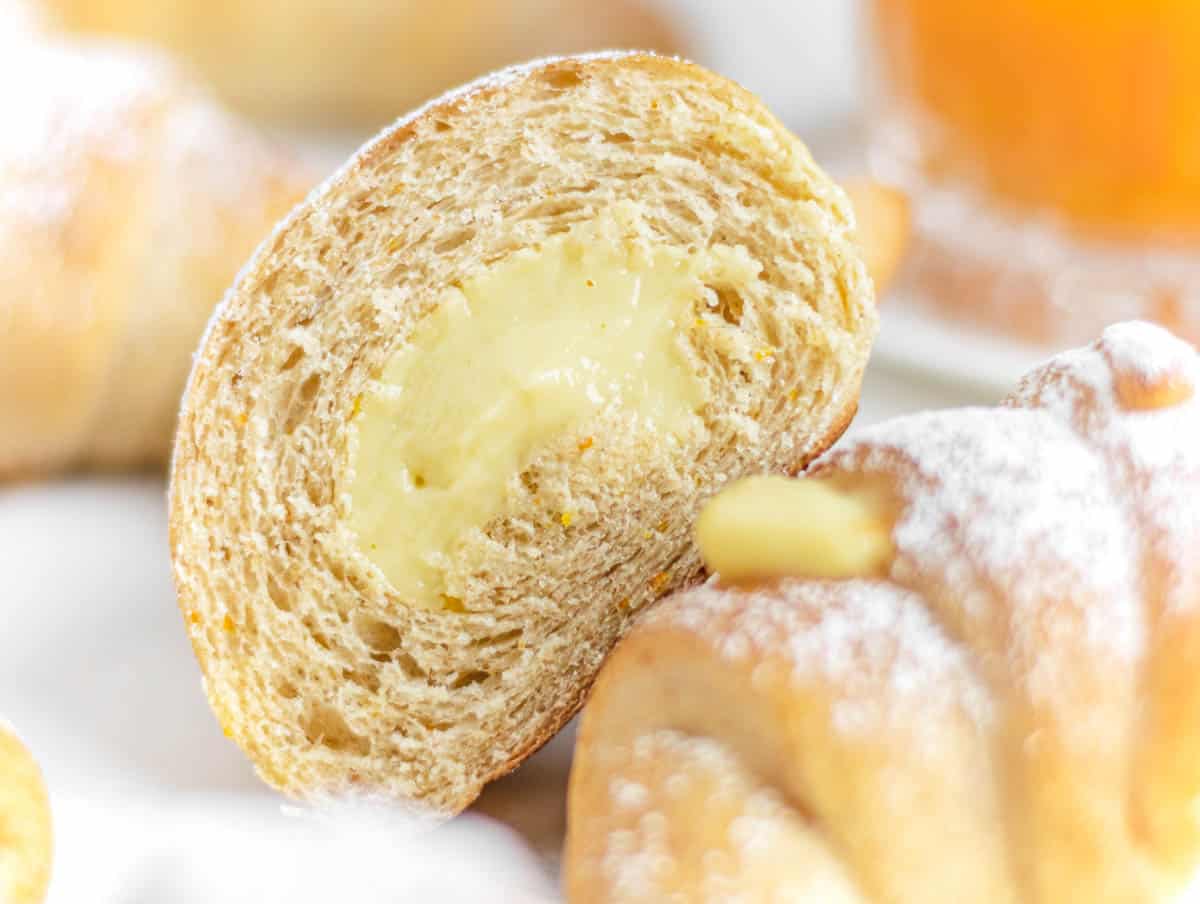
Like vegan crepes, french toast, and vegan pancakes, vegan croissants are a delicious breakfast recipe everyone loves; they are excellent for the weekend and holidays.
Here, we’ll show you how to make the best vegan croissants and fill them with a delicious homemade vegan custard, Nutella, or your favorite jam.
Ingredients & Substitutions for Vegan Croissants
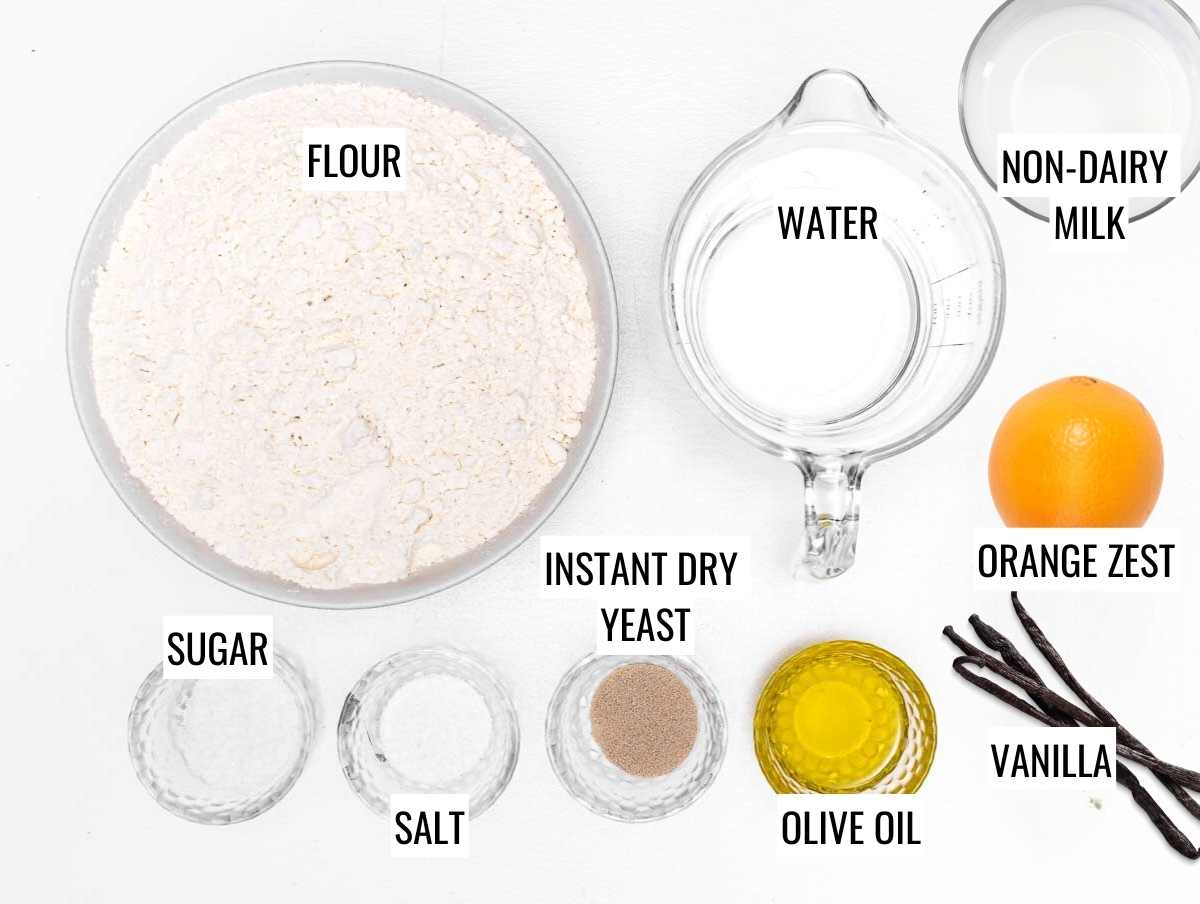
Quantities are in the recipe box at the bottom of the page.
Flour
We use all-purpose flour, bread flour, or first-clear flour.
We haven’t tried this recipe with gluten-free flour.
Sugar
Plain white sugar works best.
Substitute brown sugar or coconut sugar for white sugar. We haven’t tried maple syrup.
Instant dry yeast
We recommend instant dry yeast because it’s the easiest to use, and you can mix it right away with the other ingredients.
You can substitute fresh yeast for instant dry yeast, but if you do so, you need three times more fresh yeast than the instant dry yeast dose.
Non-dairy milk and water
You can use any dairy-free milk, such as almond milk, soy milk, rice milk, oat milk, and more.
Mix the milk with plain water to make the vegan croissants light and fluffy.
Oil
We recommend neutral vegetable oil such as mild olive oil, sunflower oil, avocado oil, or canola oil. Pick your favorite.
We don’t recommend coconut oil, extra virgin olive oil, or vegan butter here, as they make the dough less airy and more compact.
Aromas & Salt
We add vanilla extract and orange zest.
They are both delicious in this recipe, and we think they are both necessary as there are no eggs or butter to give flavor to the vegan dough.
Substitute the seeds of a vanilla pod for vanilla extract and aroma extract for orange zest.
A pinch of salt helps bring the other flavors together.
Optional fillings
- Vegan custard: you can pick a classic vegan custard, a chocolate custard, a coffee custard, or a pistachio custard.
- Vegan Nutella: you can get it in most stores or make it at home with our hazelnut spread recipe.
- Your favorite jam: we recommend apricot or strawberry jam.
If you want to fill your vegan croissants, then you’ll need a pastry piping bag with a long and thin nozzle.
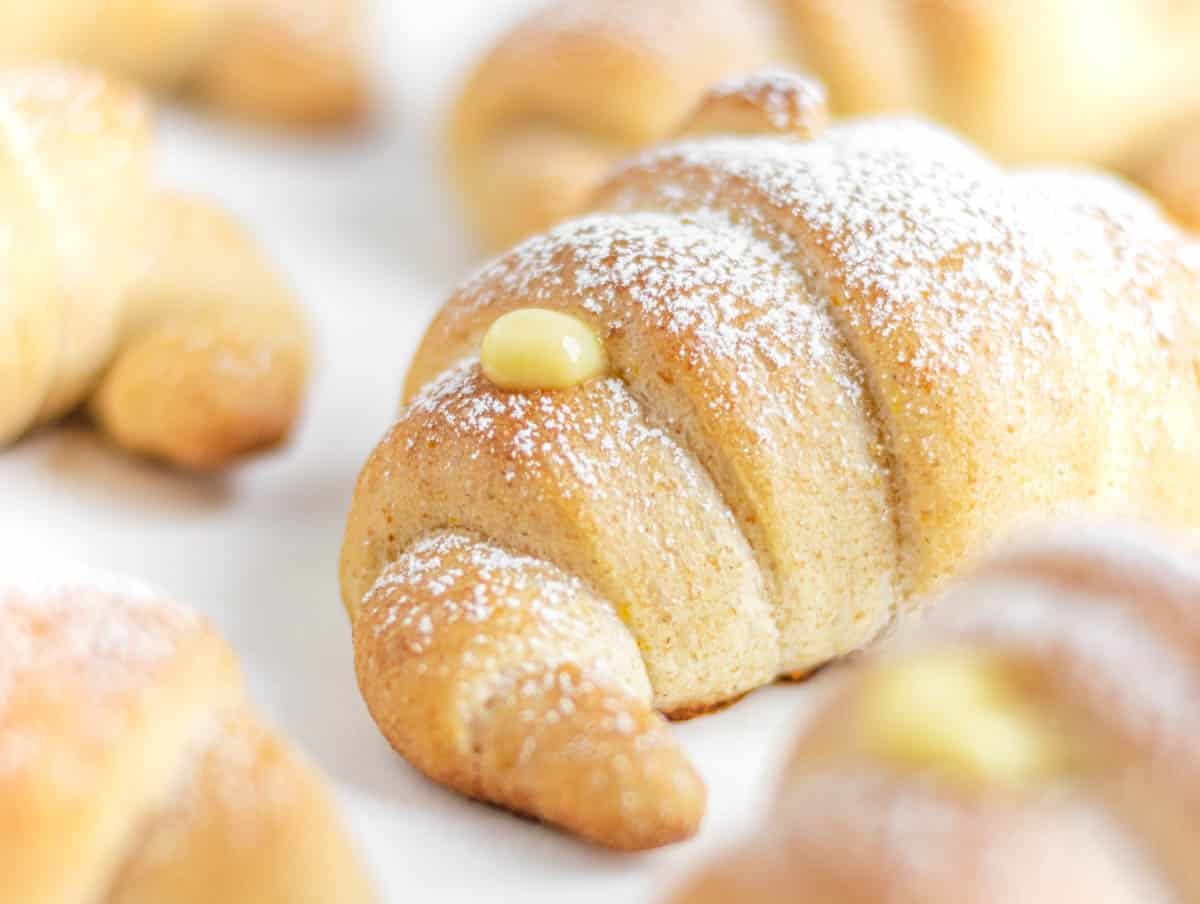
How to Make Vegan Croissants
US cups + grams measurements in the recipe box at the bottom of the page.
Make the croissant dough
In a large mixing bowl, stir together all-purpose flour, sugar, and instant dry yeast.
Add the rest of the ingredients: grated orange zest, lukewarm milk, water, olive oil, vanilla extract, and a pinch of salt.
Mix with a spatula or wooden spoon until the ingredients form a dough.
Note: if you don’t have instant dry yeast, you can use either 7g (1.4tsp) of active dry yeast or 25g of fresh yeast. In both cases, you must first dissolve the yeast in lukewarm water and sugar before adding it to the flour.

Dust a clean worktop with 2 tablespoons of flour and knead the dough with your hands for 5 minutes or until soft and smooth.
Add more flour if the dough is too sticky, but remember that your dough should be elastic, soft, and moist by the end. It should almost stick to the worktop.
Note: You can use a Kitchen Aid or any other standing mixer with a dough hook attachment to knead the dough.
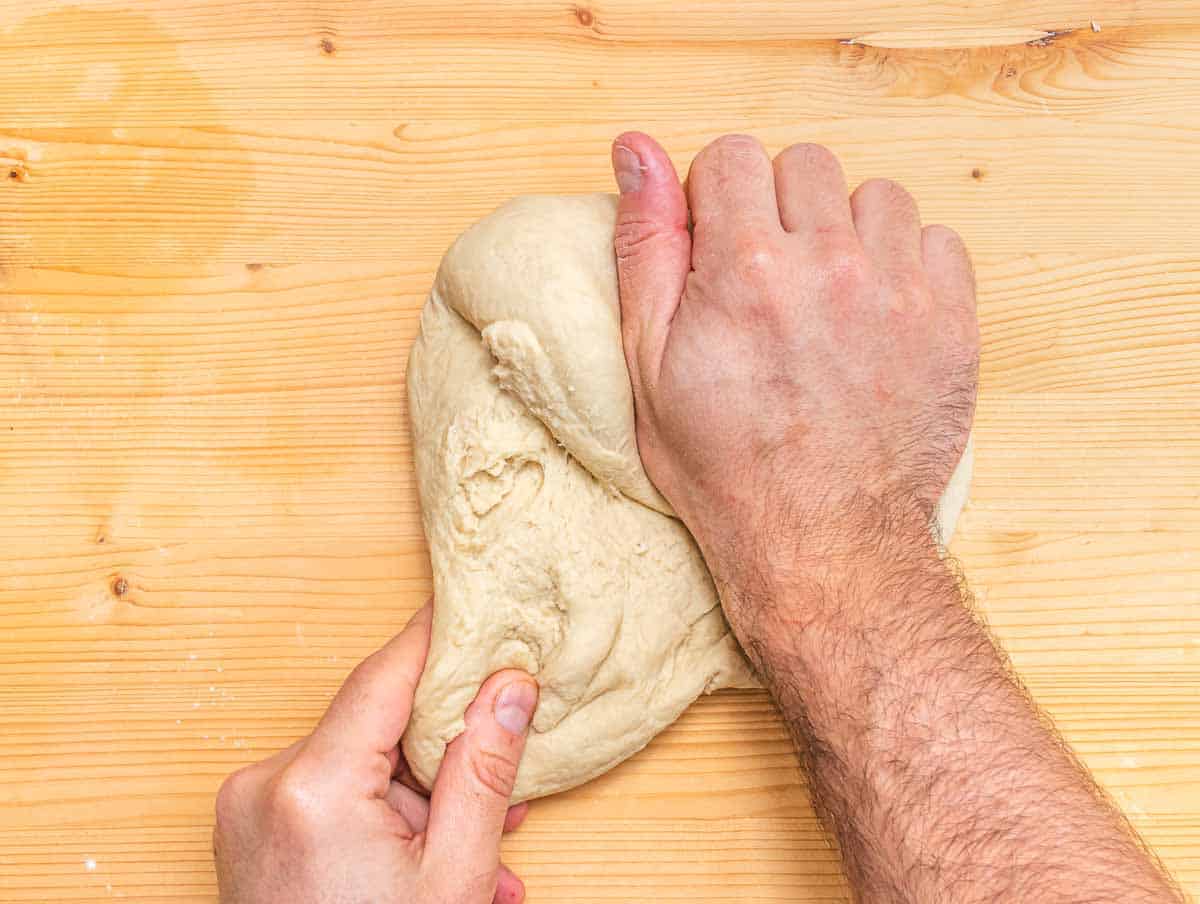
Proof the dough in a warm place
Shape the dough into a ball, then transfer it into a greased bowl, brush it with a thin layer of oil, and cover the bowl with a damp kitchen cloth, leaving enough space for the dough to double in volume.
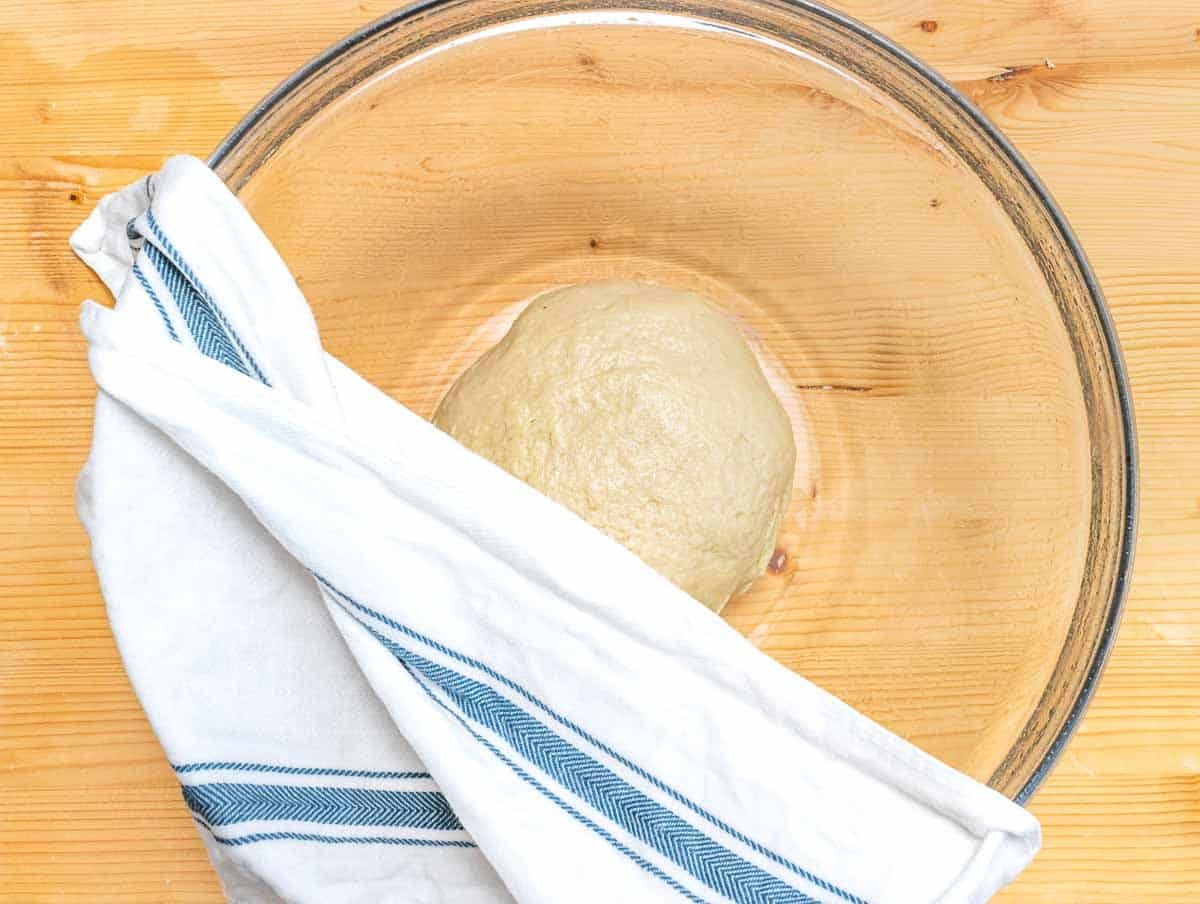
Let it proof for 2 to 3 hours in a warm place.
Tip: we recommend putting it in a slightly warm oven. Turn the oven on for 30 seconds, then turn it off and put the dough in it to proof.

Shape the vegan croissants
After proofing, transfer the dough onto a clean worktop without flour on it and flatten it into a rectangle with your hands, then with a rolling pin.
Make a rectangular shape 20 inches by 12 inches or 50cm by 30cm.
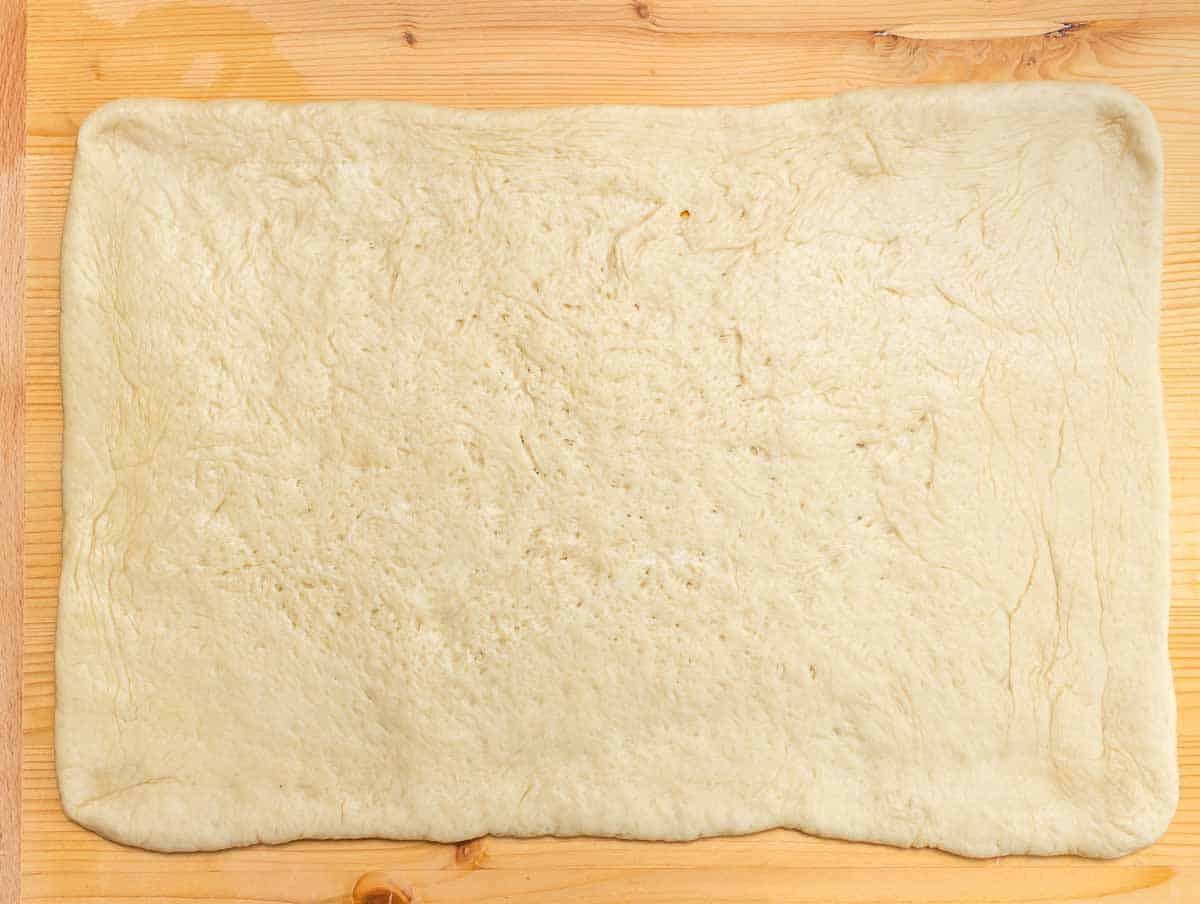
With a sharp knife or with a pizza cutter, cut the dough into 9 to 10 triangles.
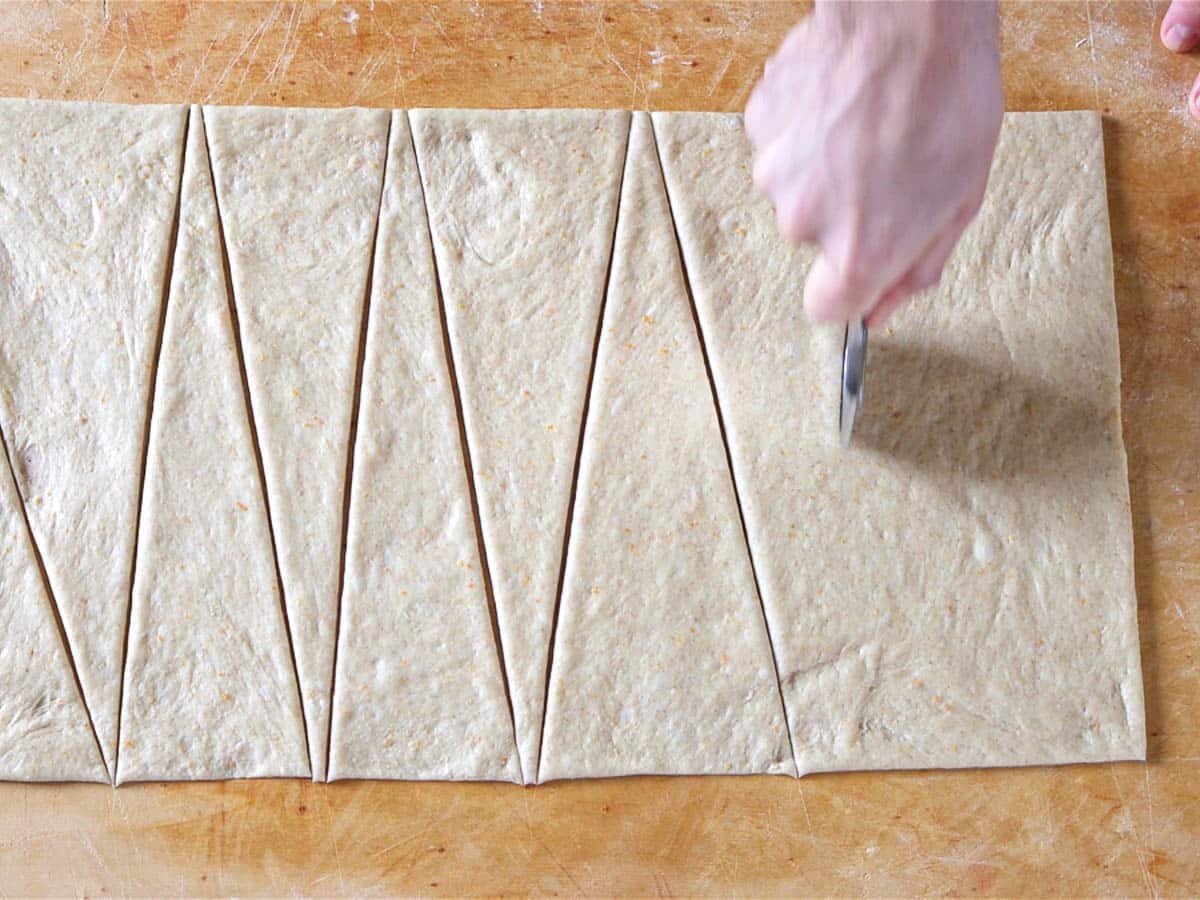
Roll each triangle on itself to give it the traditional croissant shape (crescent shape).
Knead the croissant dough scraps together, roll them out, and repeat until you run out of dough.
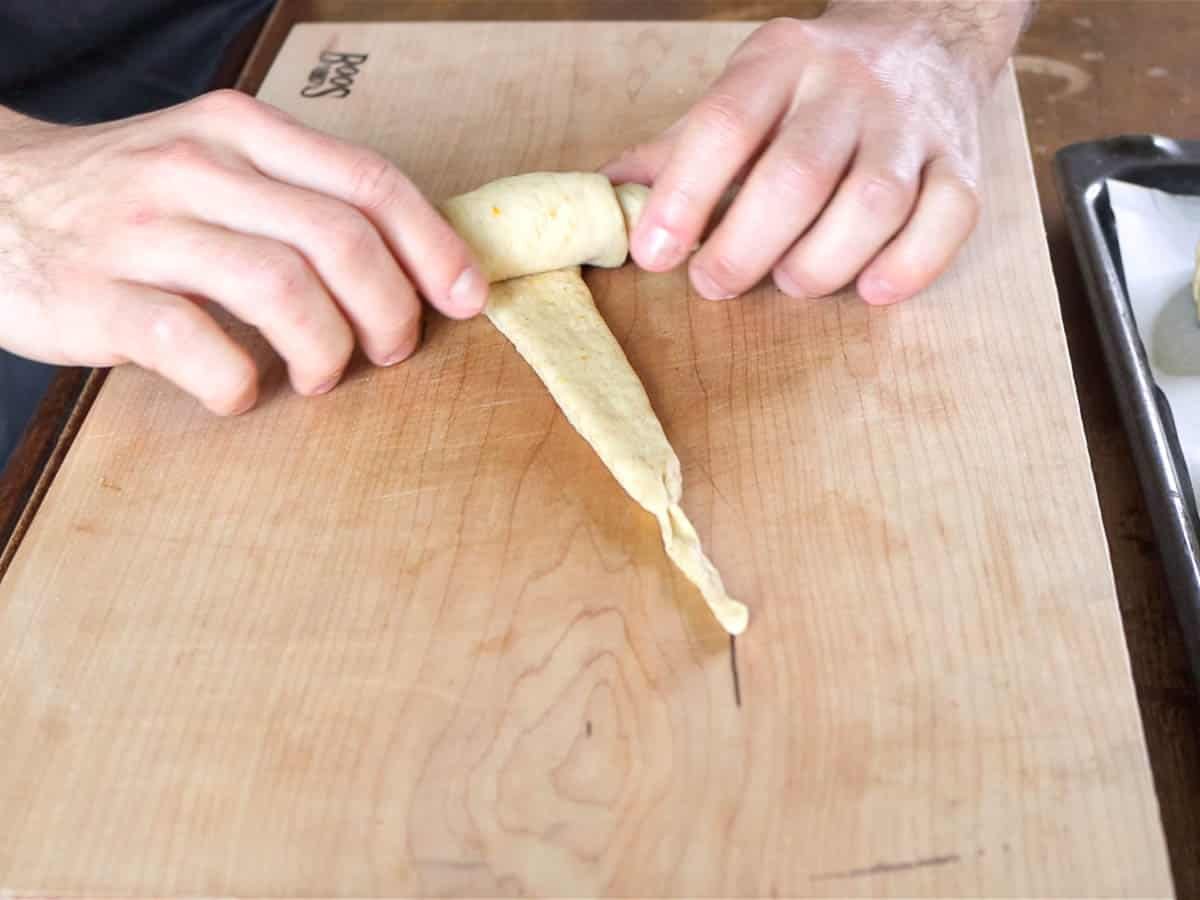
Put the croissants on a baking sheet lined with parchment paper, leaving some distance between them. On a standard tray, you should be able to fit 9 croissants.
Let them proof for 1 hour in a warm place.
Tip: turn the oven on for 30 seconds, then turn it off and put the croissants in it to proof.
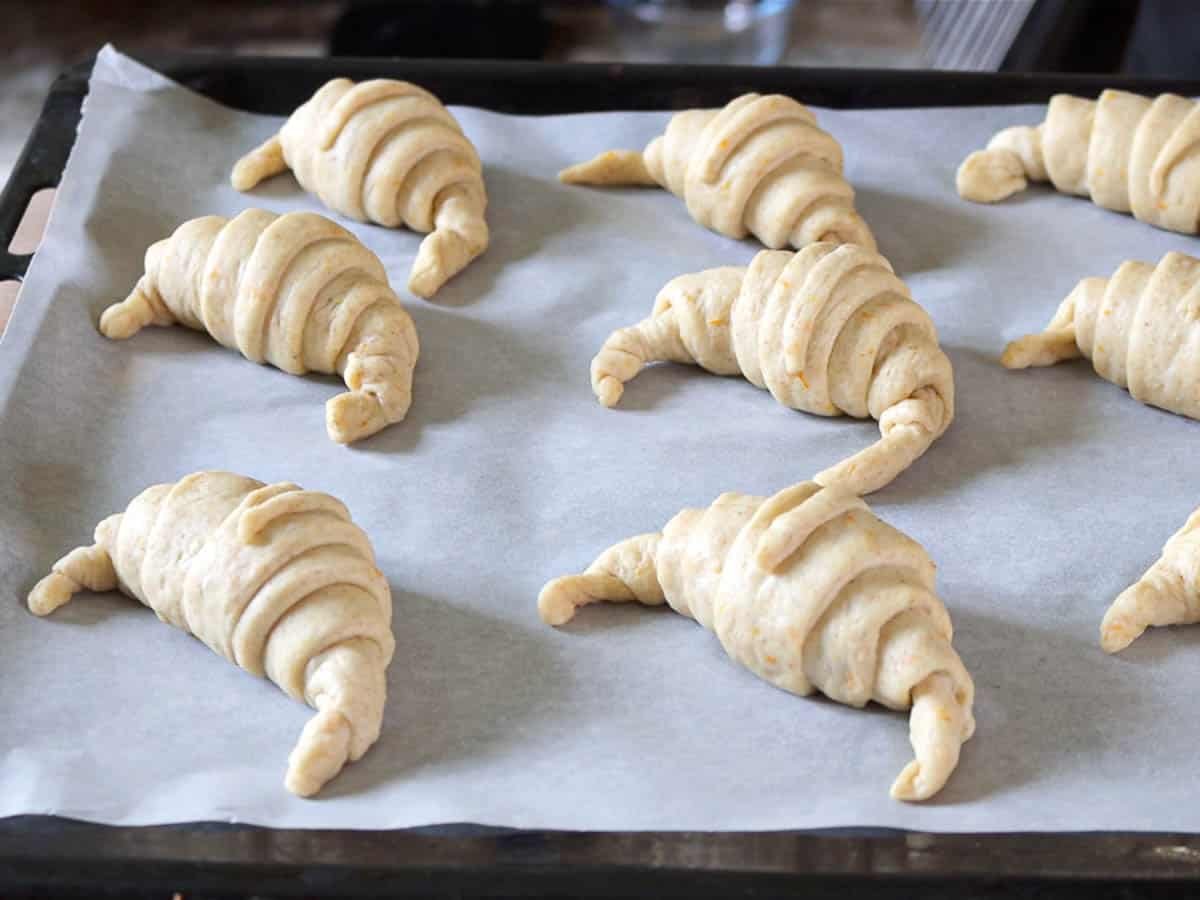
Bake the vegan croissants
Preheat the oven to 350°F or 180°C. Brush the top of the croissants with non-dairy milk (that’s our vegan egg wash) and bake on the mid-lower oven rack for around 20 minutes.
Tip: The time depends on the oven and the size of the croissant, so keep an eye on them. They should be slightly golden brown on top.
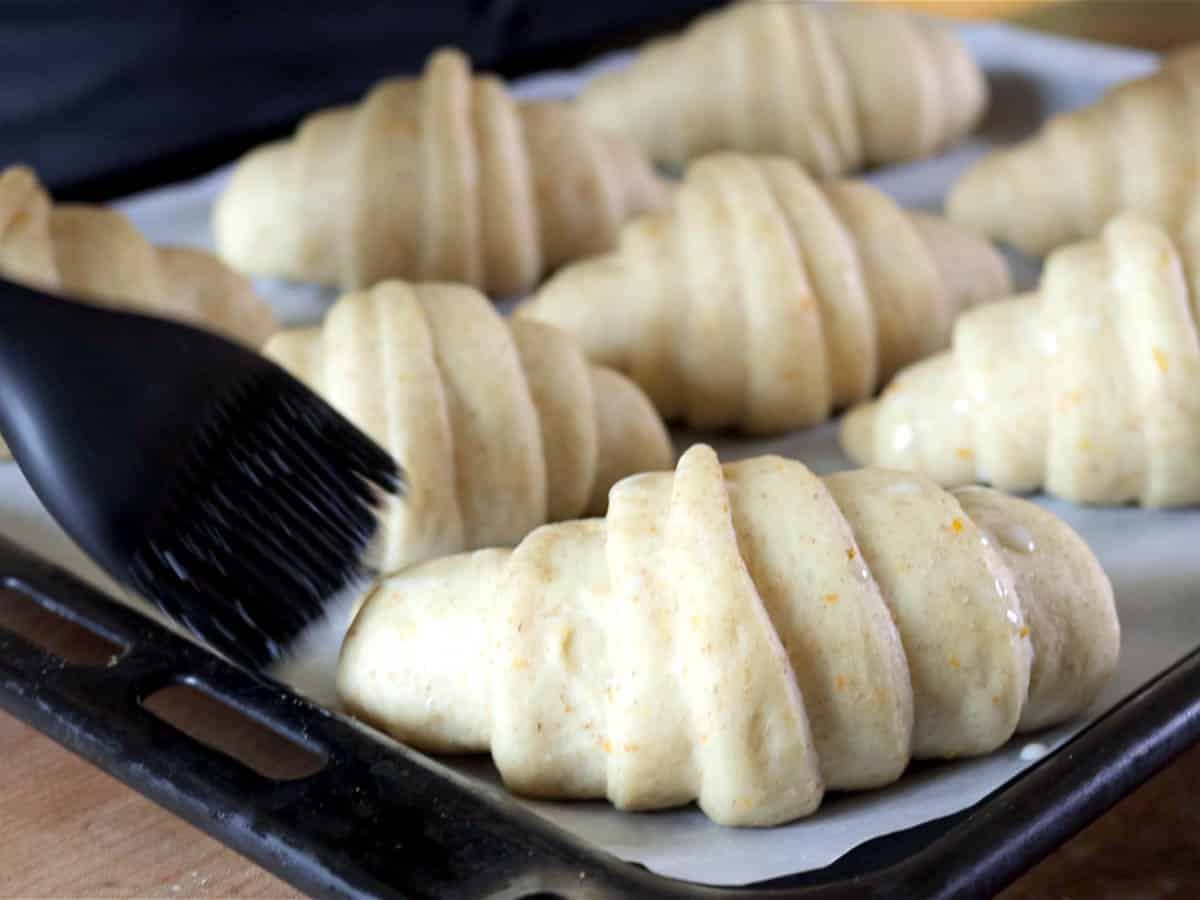
Let them cool down for 10 minutes before eating them or filling them with vegan custard, your favorite jam, or Nutella to make chocolate croissants.
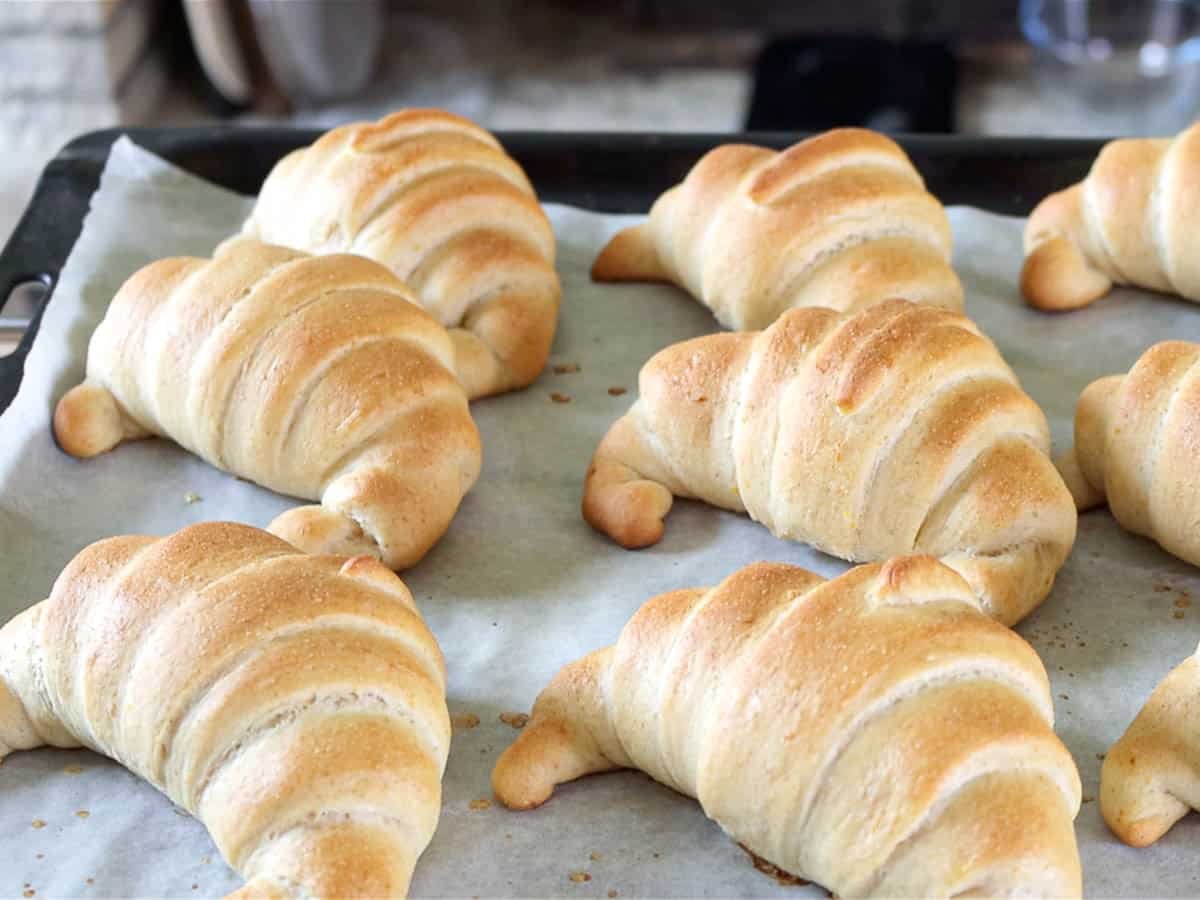
You need a pastry piping bag with a long and narrow tip to fill them.
You can do so from the top, inserting the nozzle diagonally in between one of the layers of dough, pushing it through the core, and squeezing about 2 tablespoons of filling in the croissant.

Tips
- Pick the correct type of yeast: We recommend instant dry yeast, which doesn’t require activation in warm water and sugar but can be added to the flour.
If you don’t have instant dry yeast, you can use either 7g (1.4 tsp) of active dry yeast or 25g of fresh yeast.
In both cases, you must first dissolve the yeast in lukewarm water and sugar before adding it to the flour. - Proof the dough in a warm place: turn on your oven for 30 to 45 seconds, then turn it off and put the dough proof inside it.
If you have that function, you can also keep the oven’s light on (just the light, not the heat). - Cover the dough with a damp cloth: a damp cloth is better than a piece of film because 1) it doesn’t contribute to plastic pollution, and 2) it keeps the dough moist, helping the yeast do a better job.
Remember that the dough will double or triple in volume, so leave enough space between the dough and the damp cloth. - Avoid using flour when rolling out the dough. It’s best to use little to no flour when rolling the dough so that the croissants will be soft and airy.
Questions
Croissants are neither French nor Italian but probably of Austrian origin, even though they are a very popular preparation in France and Italy.
French croissants are made with a butter-layered leavened dough similar to puff pastry. The butter flavor and flakiness are what characterize French croissants.
Italian croissants are sometimes made like French croissants. However, they are often made with less butter and a brioche-like dough.
Also, while the French croissant is neither sweet nor salty, the Italian croissant is sweet and filled with either jam, pastry cream, or Nutella.
Traditional croissants are not vegan-friendly because of the butter, and sometimes egg, in the dough.
However, most cafes and pastry shops these days sell vegan croissants.
If you drive on the Italian highway or freeway, or in some Italian airports, try a vegan croissant from “Autogrill,” the rest stop is found everywhere in Italy. They are delicious!
Storage & Make Ahead
Make ahead: you can make the croissants ahead of time and freeze them before the second proofing. To do so, shape the croissants, arrange them on a baking tray, and freeze them for 15 minutes.
When they are hard, transfer them into a freezing bag and put them back in the freezer. They keep frozen for up to 3 months.
To thaw them, remove them from the freezer, put them on a baking tray lined with parchment paper, and let them defrost at room temperature. Then let them proof for about 1 hour before baking them.
Storage: Keep leftover croissants in a reusable plastic bag at room temperature or in the fridge for up to 4 days.
We recommend reheating them in a preheated oven for a couple of minutes or in the microwave for 30 seconds to make them soft again.
Alternatively, you can freeze baked vegan croissants for about one month. In this case, let them cool completely before freezing them.

Similar Recipes
If you love baking and experimenting with leavened dough, here are some ideas for you:
- Vegan cinnamon rolls or apple cinnamon rolls.
- Vegan brioche bread or chocolate chip brioche.
- Vegan brioche swirls with custard.
- Vegan donuts.
More Breakfast Ideas
Get more delicious breakfast inspiration with these tasty and easy treats:
- Chocolate glazed donuts, easy to make, without yeast.
- Easy cake donuts.
- Apple muffins.
- Vegan pancakes.
- Egg-free French toast.
Desserts
Chocolate Glazed Donuts
Breakfast
Vegan Apple Muffins
Desserts
Zucchini Muffins
Breakfast
Vegan Pancakes
For many more breakfast ideas, check out our breakfast category page.

Vegan Croissants
Equipment
- Pastry piping bag with long nozzle (only required if you want to fill them)
Ingredients
Dry Ingredients
- 3⅓ cups all-purpose flour + 2 tablespoons for kneading
- ½ cup sugar
- 2¼ teaspoons instant dry yeast
Wet Ingredients
- ¾ cups almond milk substitute another non-dairy milk
- ½ cup water lukewarm
- ¼ cup olive oil substitute avocado oil or sunflower oil
- 1 tablespoon vanilla extract
- 1 orange the grated zest
- ¼ teaspoon salt
For the filling (optional – pick one)
Instructions
MAKE THE DOUGH
- In a large mixing bowl, stir together 3⅓ cups all-purpose flour, ½ cup sugar, and 2¼ teaspoons instant dry yeast.Add ¾ cups almond milk, ½ cup water, ¼ cup olive oil, 1 tablespoon vanilla extract, the grated zest of 1 orange, and ¼ teaspoon salt.Mix with wooden spoon until the ingredients form a dough.
- Dust a clean worktop with 2 tablespoons of flour and knead the dough for 5 minutes or until soft and smooth.Add more flour if the dough is too sticky, but remember that your dough should be elastic, soft, and moist by the end. It should almost stick to the worktop.
PROOF IN A WARM PLACE
- Shape the dough into a ball, then transfer it into a greased bowl, brush it with a thin layer of oil, and cover the bowl with a damp kitchen cloth, leaving enough space for the dough to double in volume.
- Let it proof for 2 to 3 hours in a warm place.Tip: we recommend putting it in a slightly warm oven. Turn the oven on for 30 seconds, then turn it off and put the dough in it to proof.
SHAPE THE VEGAN CROISSANTS
- After proofing, transfer the dough onto a clean worktop without flour and roll it out into a 20×12 inches (50x30cm) rectangle with a rolling pin.
- With a sharp knife or with a pizza cutter, cut the dough into 9 to 10 triangles.
- Roll each triangle on itself to give it the traditional croissant shape (crescent shape).Knead the croissant dough scraps together, roll them out, and repeat until you run out of dough.
- Arrange the croissants on a baking sheet lined with parchment paper, leaving some distance between them. You should be able to fit 9 croissants.Let them proof a second time for 1 hour in a warm place.
BAKE THE CROISSANTS
- Preheat the oven to 350°F or 180°C. Brush the top of the croissants with non-dairy milk (that’s our vegan egg wash) and bake on the mid-lower oven rack for around 20 minutes.
- Let them cool down for 10 minutes before eating them or filling them with vegan custard, jam, or vegan Nutella.
- You need a pastry piping bag with a long and narrow tip to fill them.You can do so from the top, inserting the nozzle diagonally in between one of the layers of dough, pushing it through the core, and squeezing about 2 tablespoons of filling in the croissant.
Notes
Nutrition
If you liked these vegan croissants, you might also enjoy:
Collections
30 Vegan Brunch Recipes
Collections
35 Vegan Breakfast Ideas
Collections

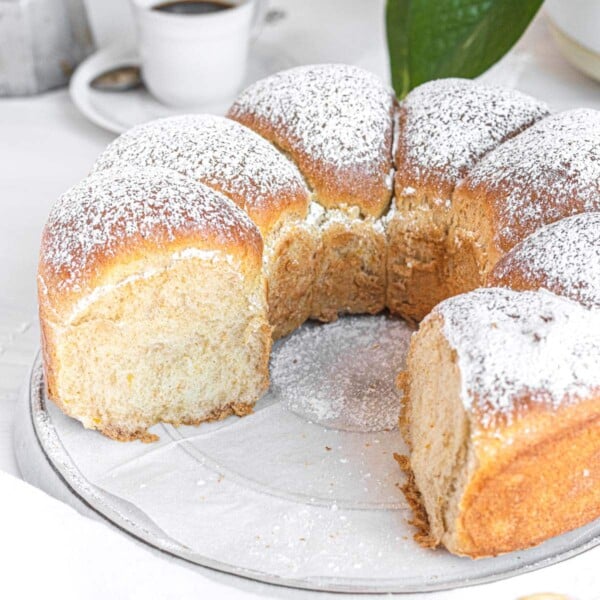
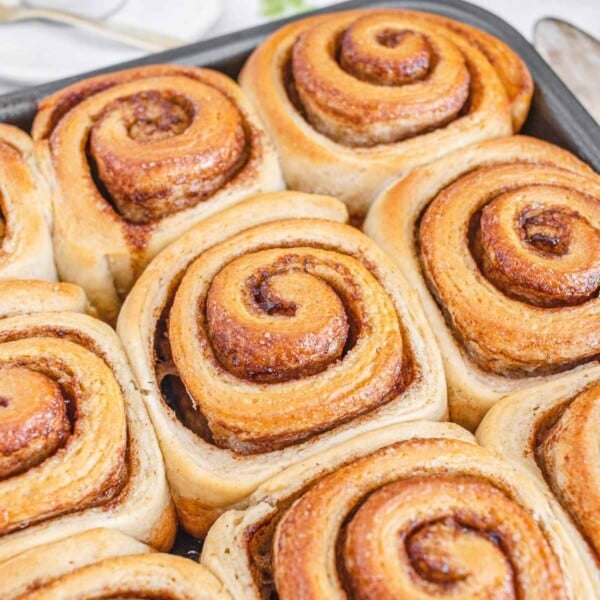
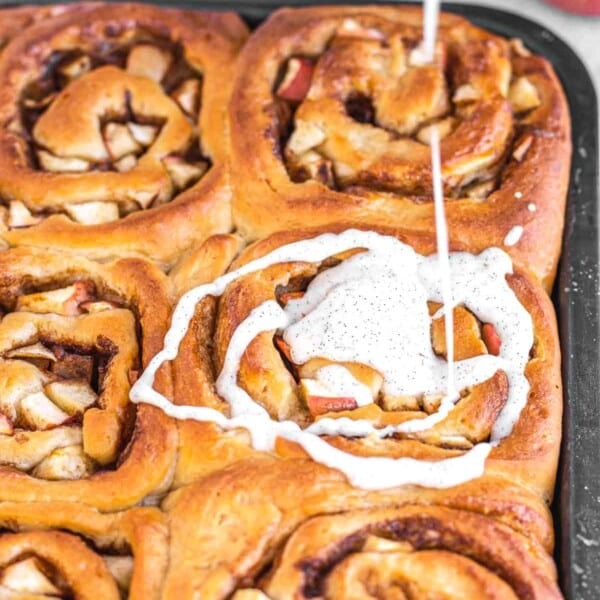

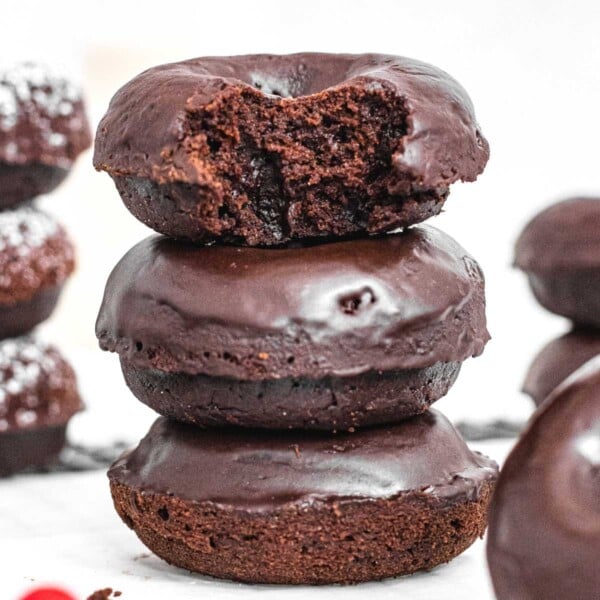
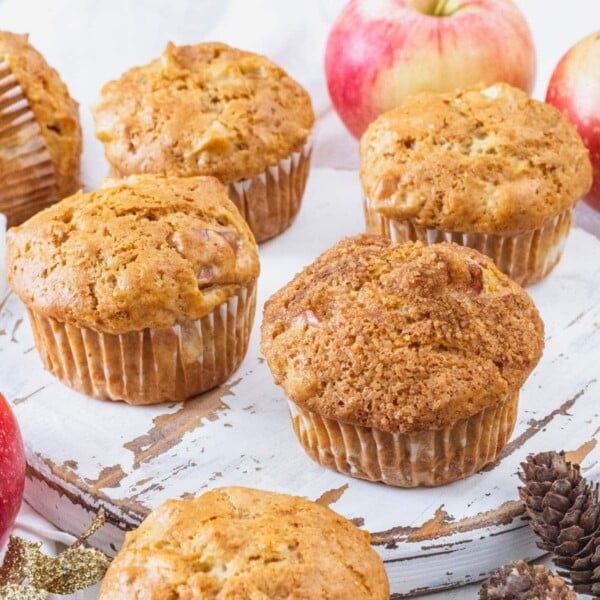
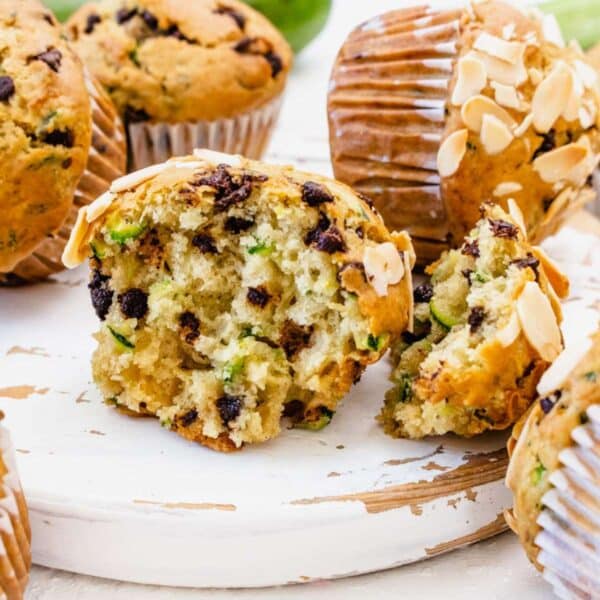
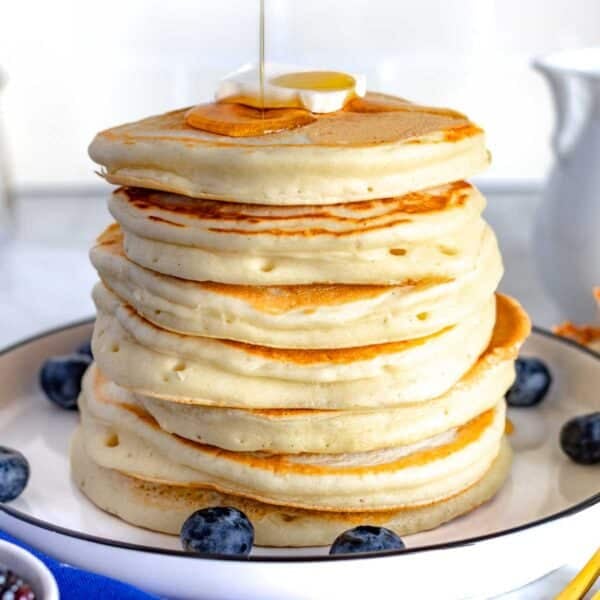
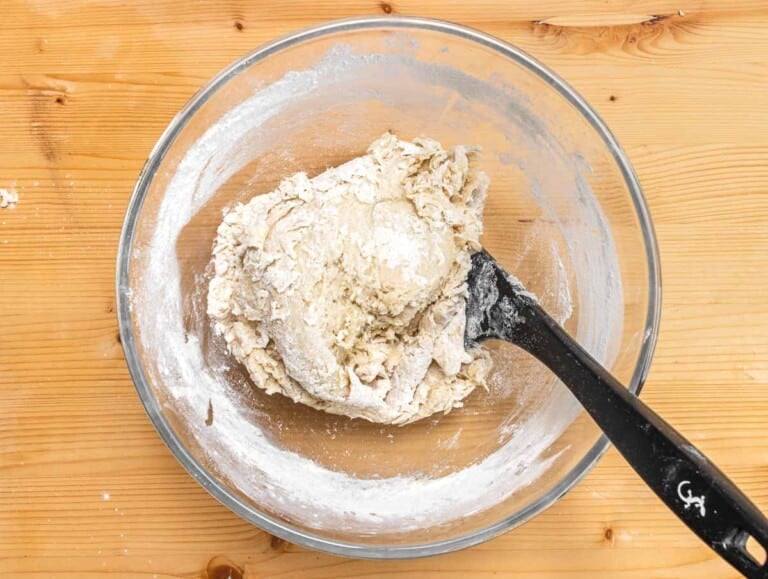
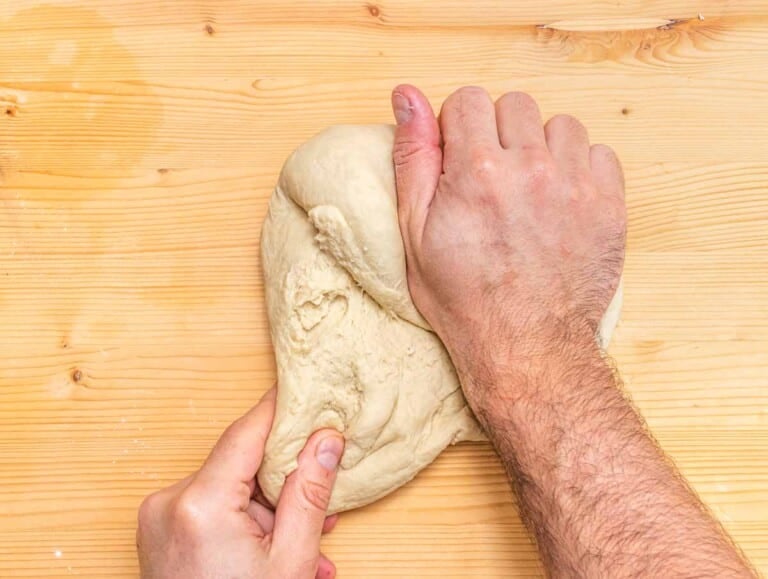
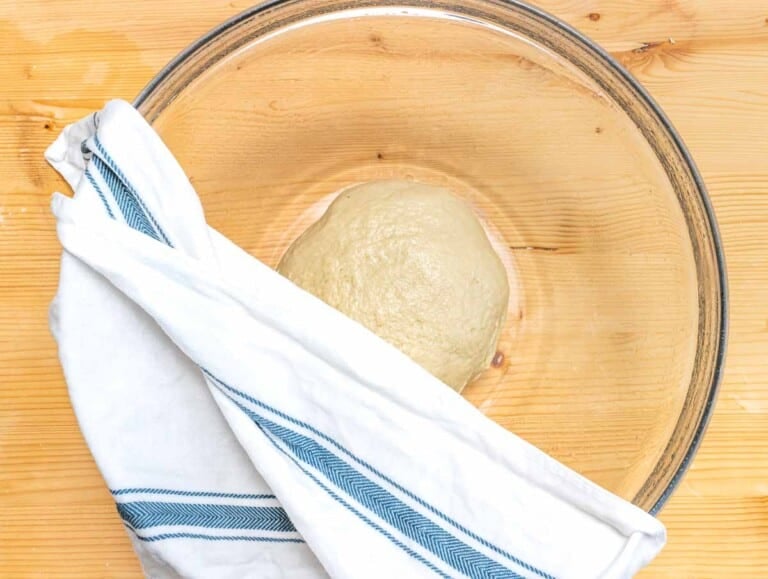

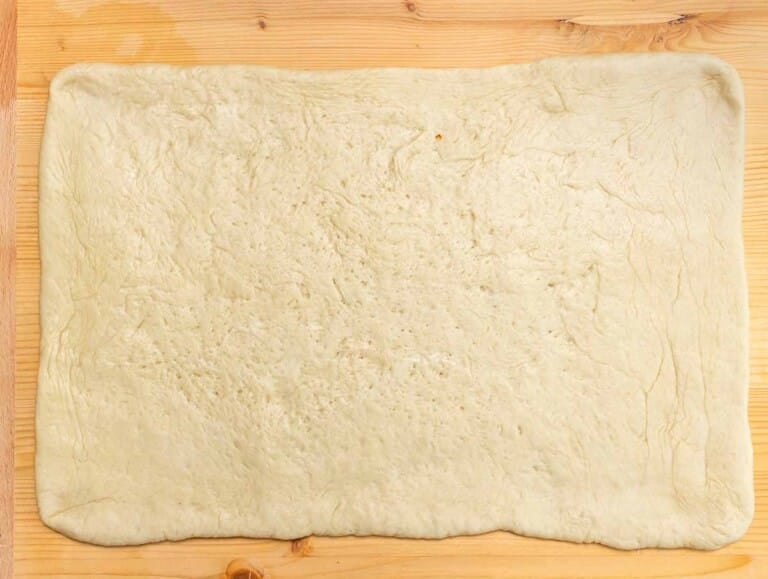
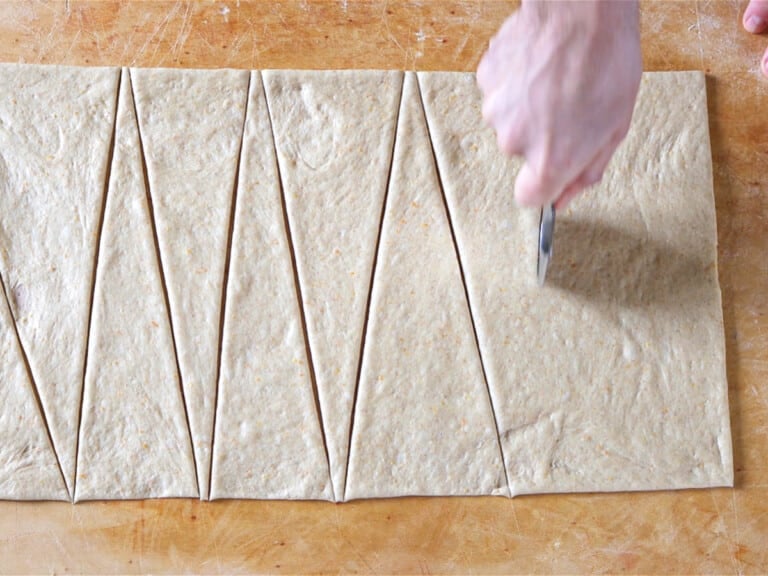
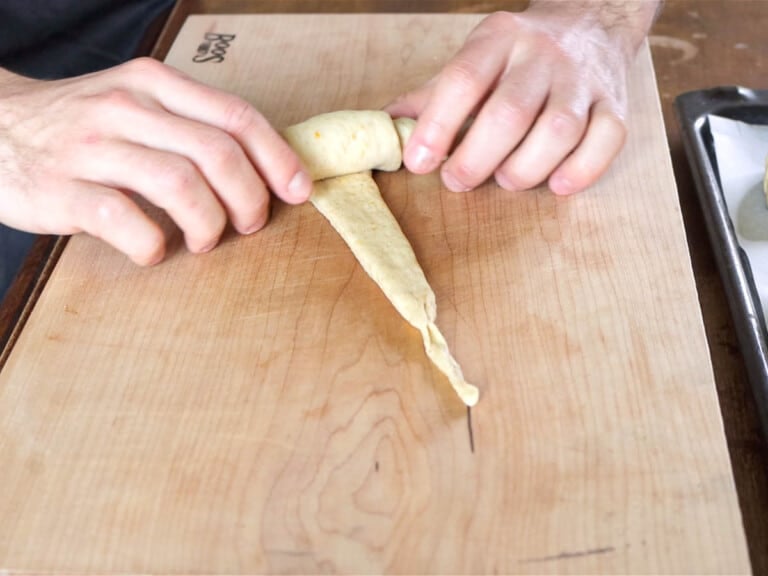
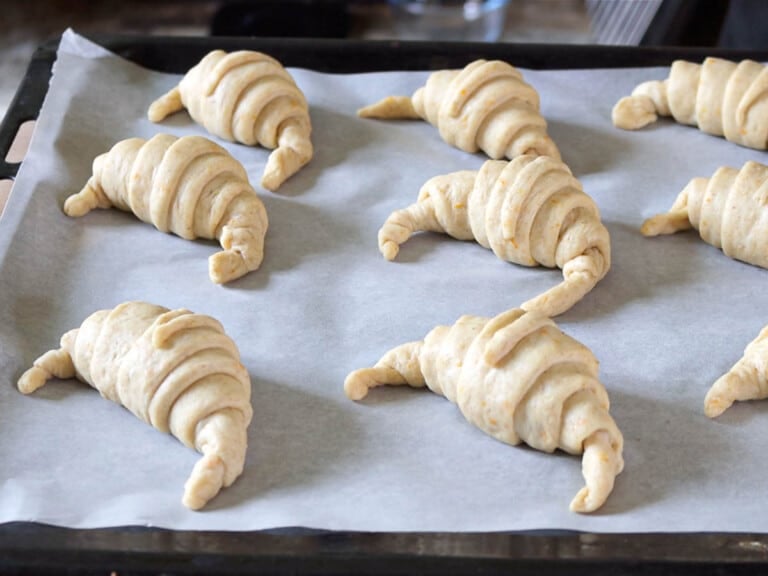
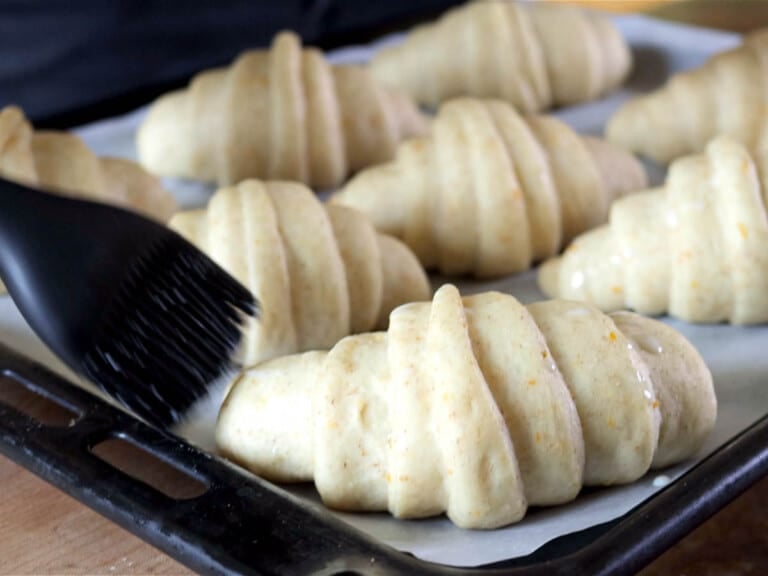

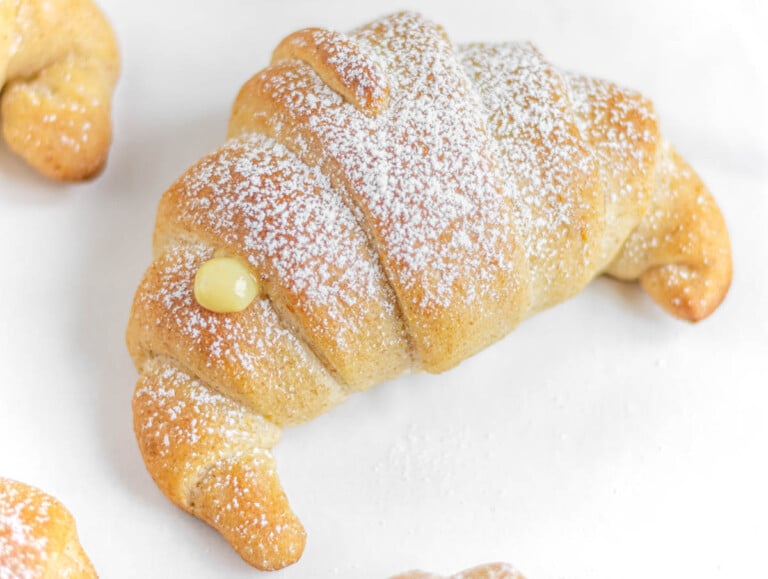

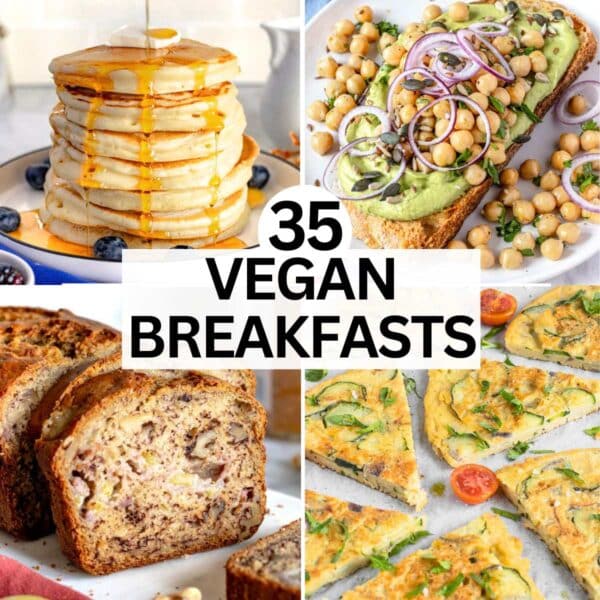



Grazie, i croissant sono buonissimi e molto soffici! Meravigliosi!
Io ho usato il lievito umido, quello in panetti, per intenderci, triplicando la dose come da consiglio, pero’ la pasta e’ venuta un troppo morbida e ho dovuto aggiungere farina in più.
Grazie ancora, le vostre ricette sono fenomenali.
Un abbraccio.
Paola
Evvivaaaa, Paola! Sono molto felice di sapere che le nostre ricette ti piacciono.
Grazie per il tuo prezioso feedback e per aver trovato il tempo di commentare qui 🥰. Best, Louise
Hello 🙂
I have a question. Do I need to add the orange zest? Will it make them taste like orange ?
Thanks you
Hi Allice,
Good questions! You don’t need to add the orange zest, it will give them croissants a refreshing cistrus-y flavor. Instead, you can add lemon zest or you can omit the zest. It’s a trick that Italians use for their brioche dough to add a little zing:-)
Happy baking. Kindest, Louise
Per avere la spiegazione della ricetta in lingua italiana?
Ciao Giovanna,
Ci stiamo spostando piano piano su un nuovo sito tutto in Italiano dove a breve potrai trovare tutte le nostre ricette.
Intanto ti lascio il link per questa ricetta in lingua Italiana -> https://theplantbasedschool.com/cornetti-con-la-crema/?lang=it
Il nuovo sito è https://tuttifoody.com/
A presto
Nico
Hi! What would be the difference between using sunflower oil verses vegan butter?
Hi Jessica, you can use melted vegan butter if you like. The nutritional difference depends on the type of vegan butter, but normally, vegan butters are made with mostly saturated fats (like palm and coconut oil) so that they are solid at room temperature. Some people for health or ethical reasons might not want to consume those products. Sunflower oil is mostly unsaturated. Personally, I think sunflower oil is a little healthier than vegan butters, and it makes the end product lighter (it’s also cheaper and often locally grown). For more info on nutrition, I’d recommend checking out the book Becoming Vegan by Brenda Davis and Vesanto Melina.
This recipe such as you’re other ones is great and practical.
Can I use grease paper instead of parchment one?
Thank you in advance
Thanks so much Zoha, I think you can from what I read online, but I haven’t tried myself actually 🙂
These turned out great!
Thanks Mariah, so happy they turned out great 🙂